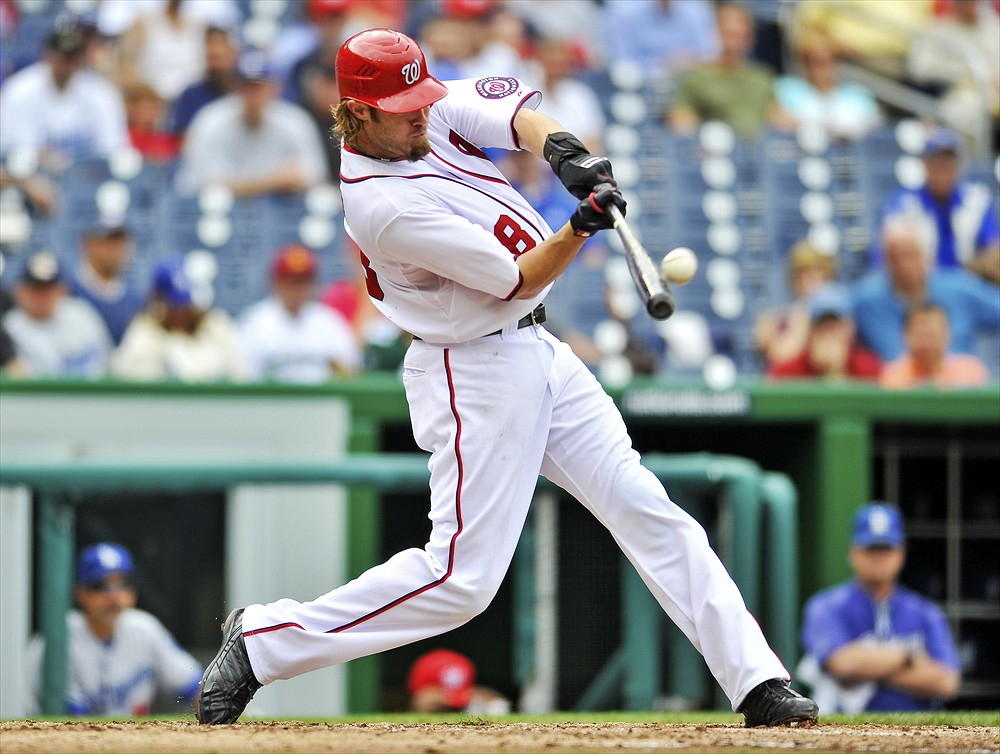Just another nice baseball photo to get the juices flowing…
Werth did indeed homer on this swing, and you can tell he got all of it. Notice how his bat is ever-so-slightly bent after making square contact.
If Werth can rebound to have a good year–even .270/.370/.470–the much-improved Nationals should win at least 85 games in 2012.


To get a good idea of what happens when the bat contacts the ball google “What if Superman Played Baseball?” Despite the comical title it is a dead serious and highly scientific article (and somewhat difficult to read and understand). For instance I learned that a curve-ball can be hit further than a fast-ball and that the tightness of the grip is not that important.
One of the questions relevant to Werth is should the Nats play him regularly in CF? He is a better hitter than anyone else they have, and if they bring up Harper sooner rather than later, and have LaRoche at 1st and Morse in left then what other alignment makes sense? It’s probably a little late to trade (pitching?, LaRoche?) for CF help.
Andy, I think your 1st “bent” was meant to be “bat”.
Happy to see more pictures from South Capitol Street.
Fixed, thanks.
Andy,
Football season is not over….there still is the matter of a parade in Manhattan :-).
On a more important note, wouldn’t Rizzo and the Nats been better off ignoring Werth, waiting, and then blowing the socks off Boras and Fielder or Lozano and Pujols? Maybe trading LaRoche for a 4th starter or a CF and platooning in RF? Obviously, we’re talking 20-20 hindsight but it seemed EVERYBODY disliked the Werth deal from the get-go.
I think it’s always been clear that the Nats overpaid quite significantly for Werth. His disastrous 2011 made the contract look really awful. But, teams like the Nats who don’t win have trouble attracting good free agents. If you’re Fielder or Pujols, wouldn’t you rather play for a team like the Angels or Tigers that has a legit shot at the playoffs right away?
But the Werth deal isn’t horrible, necessary. If he can simply revert to something closer to his career average, the other improvements the team made should be good enough to get them over .500. Then Werth can be a decent placeholder as the young players get ML-ready, and the Nats can definitely be contenders in 2013-15.
I checked for all corner OFers with enough PAs to qualify for the batting title in their age 32 season and had OPS+ numbers between 95 and 99 (Werth’s OPS+ in 2011 was 97). There were 10 other such seasons, including Jason Bay’s 2011 and nine guys from the past:
–Tim Salmon followed his disappointing 2001 (0.8 WAR) with two solid comeback seasons at ages 33 (4.1 WAR)and 34 (3.2 WAR), his final productive seasons.
–Dave Parker followed a poor 1983 at age 32 with another disappointing year at age 33, but roared back in 1985 and was second in the MVP voting and (a not particularly deserved) 5th in 1986. He was marginally productive in his late 30s.
–Ron LeFlore was never a full-time player again after his age 32 season and played his final MLB game at age 34.
–Gino Cimoli was a replacement level player his whole career so his age 32 and 33 seasons were only different because on the 1962-63 Kansas City A’s replacement level was good enough to start every day.
–Johnny Wyrostek was a 2 to 3 WAR player in his prime (early 1950s), dropped to 1.5 at age 32, and then spent a couple of final years at replacement level.
–Rip Radcliff was an OK player for a few years in the late 1930s, after getting to the majors at age 28. His age 32 season not much of a drop from his career standard. He looked done at age 33, but bounced back with a solid season at 34 before petering out.
–Mike Mitchell was a multi-tool player who had a breakout season (5.5 WAR) at age 29 in 1909, but tailed off after that and by age 32 was permanently replacement level.
–Cozy Dolan was mostly a replacement level player who had a pretty solid year in 1904 at age 31, but reverted to form at age 32 and was out of the majors a year later. In the 1920s while coaching in the majors he was thrown out of baseball in a game-fixing scandal.
–Mike Smith was a kid pitcher in the late 1880s American Association (a major league in that era) then came back as an outfielder in the 1890’s, including some excellent years with the Pirates. By age 32 he was done however.
Birtelcom — Good idea, but I’d like to see their subsequent performance evaluated on the same basis as was used to find the cohort, i.e., OPS+.
I took Birtelcom’s idea and expanded the pool a bit. For 1893-2009, I took all OFs age 31-33 (one year on either side of Werth) who qualified for the batting title and had an OPS+ of 92-102 (5 points on either side of Werth). After removing repeaters, there were 96 such players.
Then I looked at what they did over their next 2 seasons:
The median OPS+ was 94. The median WAR was 1.1 (for the 2 years combined).
The top 10 in WAR were Fielder Jones (10.0), Tim Raines (9.7), Lance Johnson (9.0), Baby Doll Jacobson (7.1), Al Bumbry and Tim Salmon (7.0), Gene Woodling (6.4), Tillie Walker (6.0), Kip Selbach (5.9) and Stan Javier (5.8).
But weren’t most of those 96 considerably worse than Werth before the comparison year? rWAR has him at 12.5 for 2008-10 and fWAR has him at >= 5.0 each of those years. The projections for 2012 that I have seen suggest 4+ WAR or there-abouts.